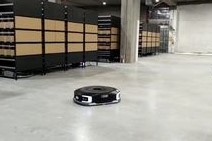
Enhancing AMR System Performance with PrimX Concrete Technology
Autonomous Mobile Robots (AMRs) represent the next generation of Automated Guided Vehicle (AGV) systems. While AGVs follow predetermined routes, AMRs offer unparalleled flexibility, navigating around obstacles and adapting routes on the fly.
AMRs vs. AGVs
AMRs outshine AGVs in terms of adaptability and versatility. AGVs follow fixed routes, often limited to specific tasks like point-to-point material transport. In contrast, AMRs can be equipped with various attachments, accommodating a wide range of tasks. These robots frequently collaborate with warehouse operatives, facilitating tasks such as stock movement, replenishment retrieval, and bulk stock transfers, streamlining warehouse operations.
Movement Capabilities
AMRs excel in a variety of material movement tasks within warehouses, including pallet movement, cart transportation, and rearranging shelving and racking. Their ability to operate autonomously within existing warehouse layouts minimizes disruption to ongoing operations.
Key Features of AMRs:
Infrastructure Independence: in many applications, AMRs do not require specialized infrastructure and are ready to seamlessly integrate into existing warehouse layouts as long as the floor is at set specifications
Sensor and Map Integration: Equipped with onboard sensors and mapping technology, AMRs can plan routes and adapt to changing environments in real-time.
Multi-Purpose Functionality: AMRs are not limited to warehouse tasks; they can also perform routine activities such as inventory counting.
The Importance of Concrete Floors for AMR System Performance
The quality of the floor surface plays a pivotal role in ensuring optimal AMR performance. Several factors influence this performance:
Floor Flatness:
The floor must be flat to provide an optimal surface for mobile robots, especially when operating at higher speeds or handling taller shelves and goods.
Floor Design:
Joints in the floor slab can pose challenges to AMR systems. Joint openings, deteriorated edges, and curled joints can impede robot movement, cause slowdowns, equipment damage, and safety concerns.
Surface Quality:
Factors like floor surface friction, micro-roughness, and reflection become crucial, particularly for AMRs using optical sensors. Abrasion resistance is vital for longevity, given the repetitive nature of robotic traffic.
6 Reasons Why PrimX Concrete Technology Is Ideal for Your AMR Project:
- Lifetime Flatness: PrimX slabs remain flat from casting, ensuring precision and optimal AMR performance.
- Jointless Design: A jointless layout eliminates irregularities and obstacles that could hinder AMR operations and reduces maintenance.
- Reduced CO2 Emissions and Environmental Sustainability: PrimX slabs are thinner without compromising load-bearing capacity, leading to reduced CO2 emissions and environmental levy costs.
- Dimensional Stability: PrimX's Steel Fiber Reinforced Self-Stressing Concrete offers a stiff and durable platform for heavy and precise automated systems.
- Faster Construction:Prīm X SFRSSC offers the advantage of being ready for use in just 14 days after pouring. Unlike traditional concrete floors, which necessitate a 30 day curing period. PrīmX lets you get your facility up and running faster. The substantial decrease for steel bar reinforcement in the floors and more efficient and productive construction techniques lead to accelerated construction timelines and enhanced overall efficiency in the building process.
- Cost Efficiency: Optimized design, simpler construction, shorter timelines, and overall schedule reductions translate to significant cost savings.
In conclusion, PrimX concrete technology represents a game-changer for optimizing AMR system operations, ensuring floor quality that matches the capabilities of these advanced robots. Investing in high-quality flooring is a strategic move toward achieving peak AMR performance while simultaneously reducing costs and environmental impact.